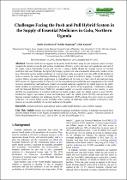| dc.contributor.author | Okello, Tom Richard | |
| dc.contributor.author | Mshilla, Maghanga | |
| dc.contributor.author | Olido, Kenneth | |
| dc.date.accessioned | 2021-05-23T11:01:13Z | |
| dc.date.available | 2021-05-23T11:01:13Z | |
| dc.date.issued | 2015 | |
| dc.identifier.citation | Okello Tom Richard, Mshilla Maghanga, and Olido Kenneth, “Challenges Facing the Push and Pull Hybrid System in the Supply of Essential Medicines in Gulu, Northern Uganda.” American Journal of Public Health Research vol. 3, no. 3 (2015): 106-112. doi: 10.12691/ajphr-3-3-5 | en_US |
| dc.identifier.uri | DOI:10.12691/ajphr-3-3-5 | |
| dc.identifier.uri | https://hdl.handle.net/123456789/261 | |
| dc.description.abstract | Essential medicines are supplied to the public health facilities using the pull and push system. In many countries the decision to use the pull, push or combination of both is a policy decision, but Uganda has used each of the supply system individually in past and currently is using a hybrid despite the rampant out-cry of essential medicines stock out. Challenges facing the hybrid supply system need to be examined to advise policy makers on the how efficient the system supplies medicines. A cross-sectional study was carried out in the public health facilities in Gulu to examine the major challenges affecting the hybrid system of medicines supply. A sample of 131 health workers filled a pretested coded questionnaire as respondents and the data were then entered and analysed using SPSS version 15. Approximately 27.7% (n=131) of the respondents reported that the store management in the hybrid system is unsatisfactory and inadequate. Quality of essential medicines supplied in the hybrid system to the public health facilities is unsatisfactory and inadequate as reported by 46.5% of the respondents. Collaborative linkages with the National Medical Stores (NMS) the mandated supplier of essential medicines in the country, is weak (42.9%) and quantification of essential medicines by health workers under the hybrid system is poor (33.3%). Furthermore support supervision in weak and inadequate under the hybrid system (37.6%); and personnel who dispense essential medicines are inadequate (44.3%). Approximately 30.3% patients have poor access to essential medicines. The current hybrid system is riddled with a number of challenges which requires re-dressed in order improve access and availability of essential medicines to the public. | en_US |
| dc.language.iso | en | en_US |
| dc.publisher | American Journal of Public Health Research | en_US |
| dc.subject | essential medicines | en_US |
| dc.subject | push and pull system | en_US |
| dc.subject | public health facilities | en_US |
| dc.subject | Gulu | en_US |
| dc.subject | northern Uganda | en_US |
| dc.title | Challenges Facing the Push and Pull Hybrid System in the Supply of Essential Medicines in Gulu, Northern Uganda | en_US |
| dc.type | Article | en_US |

